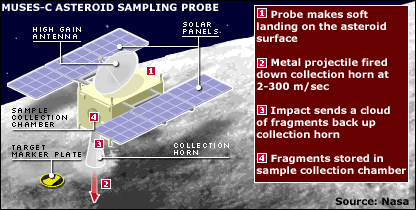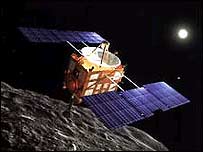Hayabusa (MUSES-C)

Hayabusa (MUSES-C) was the first sample-return mission to an asteroid. This Japanese spacecraft was launched by ISAS (Institute of Space and Astronautical Science) on 9 May 2003 and used solar-electric propulsion to rendezvous with asteroid Itokawa (1998 SF36) in September 2005. Hayabusa ("peregrine falcon") – previously known as MUSES-C – "parked" about 20 kilometers away from its target on 12 September and immediately began mapping and carrying out measurements to determine the asteroid's surface composition. For several weeks it relied on autonomous navigation and guidance while its optical navigation camera, lidar, laser range finder, and fan-beam sensors gathered topographic and range information about the object's surface. At the end of September, it approached to about 7 kilometers from the 630-meter-long asteroid and made a more detailed map. After building a three-dimensional model of the asteroid during this mapping phase, the Hayabusa project team decided on suitable sites for surface exploration.
Minerva mini-lander
During its initial descent to the surface in November 2005 (see below), Hayabusa deployed a coffee-can-sized mini-lander named Minerva, which weighs a mere 519 grams. Taking advantage of the very low gravity at Itokawa, this solar-powered, box-shaped vehicle was intended to hop along the surface of the asteroid, relaying images from its cameras to Hayabusa whenever the two spacecraft were in sight of each other. Minerva was intended to become the first successful "space hopper".
Sample collection and return
 |
To capture samples, Hayabusa was meant to utilize a fabric horn. In November 2005, the spacecraft descended toward the asteroid and briefly (for just a second or so) allowed the cone to make contact with the surface. On each occasion, a small pyrotechnic charge fired a bullet into the surface at 300 meters per second and fragments of the impact were intended to be captured by the horn and funneled into a sample container. On each of the sampling attempts the spacecraft began its approach at some distance from the asteroid, moved in to collect the sample, and then backed off to the same distance. The samples, with a total mass of about one gram, were to have been held inside a separate reentry capsule.
After a few months exploring Itokawa, the spacecraft was meant to fire its engines to begin its cruise back to Earth. In the final phase of the mission, the reentry capsule is intended to be detached from the main spacecraft at a distance of 300,000 to 400,000 kilometers from Earth and then coast on a ballistic trajectory, reentering Earth's atmosphere in July 2007. All being well, the capsule and its tiny cargo was to have landed via parachute near Woomera, Australia.
13 September 2005:
Hayabusa successfully approached to within 20 kilometers (12 miles) of Itokawa to
begin the initial observing phase.


